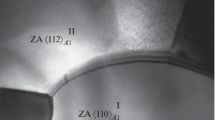Abstract
The initial formation and the subsequent early and late stage growth of the α1 plates in Cu-Zn and Cu-Zn-AI alloys are studied by optical microscopy, transmission electron microscopy (TEM), and high-temperature TEMin situ. Single-phase α1 plates (initial α1 plates) can be obtained only at the early stage of isothermal transformation. Striations corresponding to stacking faults are observed during the nucleation of initial α1 plates. A strong and discontinuous strain-stress field exists in front of the tips of initial α1 plates and causes inducing nucleation and crossing growth. The displacement between stacking fault faces and the thickening along the direction of streaking contrast show that the growth of initial α1 plate has the nature of shear transformation, and the shear direction along the streaking contrast corresponds to stacking faults. The superledges at the broad faces of the α1 plates are also observed, but they move only along the direction of streaking contrast during plates thickening. The “overannealing” of initial α1 plates during longer transformation time results in the disappearing of stacking faults, and corresponding initial α1 plates are partially or completely “degenerated” into equilibrium α phase (here designated as late α1 (α) plates). The thickening kinetics of late α1 (α) plates seems to be compatible with the diffusional ledge mechanism, but the lateral movement of superledges along the broad faces of late α1 (α) plates is not observed. According to the facts mentioned previously, a possible atomic mechanism for the formation of the α1 plates is suggested.
Similar content being viewed by others
References
H.K.D.H. Bhadeshia:Mater. Sci. Forum, 1990, vol. 56–58, pp. 263–74.
K. Chattopadhyay and H.I. Aaronson:Acta Metall., 1986, vol. 34, pp. 695–711.
G. Cliff, F. Hasan, G.W. Lorimer, and M. Kikuchi:Metall. Trans. A, 1990, vol. 21A, pp. 831–35.
T.Y. Hsu and X.W. Zhou:Acta Metall. Mater., 1991, vol. 39, pp. 2615–19.
M. Han, F.M. Chen, J.M. Chen, Y.R. Chen, and W.X. Liu:Acta Metall. Sinica, 1990, vol. 26, pp. A81-A85.
J.X. Dong, F.M. Chen, J.M. Chen, and W.X. Liu:Acta Metall. Sinica, 1990, vol. 26, pp. A467-A469.
M.H. Wu, J. Perkins, and C.M. Wayman:Acta Metall., 1989, vol. 37, pp. 1821–37.
Q. Jin, H.S. Fang, J.J. Cao, Y.K. Zheng, and X.Y. Chen:Acta Metall. Sinica, 1990, vol. 26, pp. A391-A395.
P.E.J. Flewitt and J.M. Towner:J. Inst. Met., 1967, vol. 95, pp. 273–80.
K. Takezawa and S. Sato:Metall. Trans. A, 1990, vol. 21A, pp. 1541–45.
F.Y. Gong, Y.R. Chen, J.M. Chen, Q.S. Liu, and L.B. Yang: Chinese Society of Metals, Beijing,Proc. 2nd Nat. Conf. on Bainitic Reaction, Emei, China, 1990, pp. 77–79.
Y.Q. Yang, D.H. Liu, M.K. Kang, and Y. Sun:Acta Metall. Sinica, 1992, vol. 28, pp. A95-A99.
H. Fujita and S. Ueda:Acta Metall., 1972, vol. 20, pp. 759–67.
X.K. Meng, M.K. Kang, Y.Q. Yang, X.N. Zhao, and J.M. Hong: J. Chin. Elec. Micro., 1993, vol. 12, No. 4.
I. Cornelis and C.M. Wayman:Acta Metall., 1974, vol. 22, pp. 291–300.
W.X. Liu, X.Y. Huang, and Y.R. Chen:The Microstructure Analyses by Electric Microscopy, Tianjin University Press, Tianjin, 1989, pp. 328–39 (in Chinese).
Y. Nakata, T. Tadaki, and K. Shimizu:Mater, Trans. JIM, 1989, vol. 30, pp. 107–16.
Y.Q. Yang: Ph.D. Thesis, Northwestern Polytechnical University, Xi’an, People’s Republic of China, 1991, pp. 70–80.
Q.M. Wei: Ph.D. Thesis, Northwestern Polytechnical University, Xi’an, People’s Republic of China, 1991, pp. 30–54.
T.Y. Hsu:J. Shanghai Met., 1991, vol. 13, pp. 7–12 (in Chinese).
Author information
Authors and Affiliations
Additional information
formerly with Northwestern Polytechnical University
formerly with Northwestern Polytechnical University
This article is based on a presentation made at the Pacific Rim Conference on the “Roles of Shear and Diffusion in the Formation of Plate-Shaped Transformation Products,” held December 18-22, 1992, in Kona, Hawaii, under the auspices of ASM INTERNATIONAL’S Phase Transformations Committee.
Rights and permissions
About this article
Cite this article
Meng, X.K., Kang, M.K., Yang, Y.Q. et al. The formation mechanism of plate in beta Cu-Zn and Cu-Zn-Al alloys. Metall Mater Trans A 25, 2601–2608 (1994). https://doi.org/10.1007/BF02649212
Issue Date:
DOI: https://doi.org/10.1007/BF02649212




